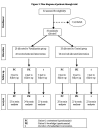Improvement of the educational process by computer-based visualization of procedures: randomized controlled trial
- PMID: 15249265
- PMCID: PMC1550596
- DOI: 10.2196/jmir.6.2.e16
Improvement of the educational process by computer-based visualization of procedures: randomized controlled trial
Abstract
Background: Before any invasive procedure, physicians have a legal obligation to inform patients. Traditionally, this involves a discussion with a physician, supplemented by written leaflet information directed at the specific procedure.
Objective: Comparison of the use and effectiveness of computer-based visualization opposed to standardized conversation for providing patients with information of forthcoming procedures (coronary catheters or endoscopy procedures).
Methods: Prospective, randomized trial with 56 participants allocated in two different groups: Visualization Group (standardized information supported by a tool for displaying two-dimensional pictures to explain medical facts as well as informative leaflet) or Control Group (standardized information and informative leaflet only). Detailed information was given about the indication, the probable complications and the details of the forthcoming procedures (coronary catheters or endoscopy procedures). All participants had to reach a Karnofsky Score of 70 points and be able to understand German or English. Main outcome measures were patient's satisfaction with physician-patient conversation, patient's acquired knowledge and duration of the intervention as described above.
Results: Patients of the Visualization Group were more satisfied with the conversation and had higher knowledge scores after the conversation. A Mann-Whitney-U-Test between the two groups showed that these differences in satisfaction (P<0.001) and knowledge (P= or <0.006) were statistically significant. Length of time needed for the conversation was slightly higher in the Visualization Group, but this difference was not statistically significant (25 versus 23 min; P= 0.441). No differences could be found due to differing age or educational level in the results of the Visualization and the Control Group.
Conclusions: Using computerized visualization increased the satisfaction and knowledge of the patients. The presentation of the visualized information in the Visualization Group did not demand significantly more time than the standard conversation in the Control Group.
Conflict of interest statement
None declared.
Figures
References
-
- Towle A, Godolphin W. Framework for teaching and learning informed shared decision making. BMJ. 1999 Sep 18;319(7212):766–71. http://bmj.com/cgi/pmidlookup?view=long&pmid=10488010. - PMC - PubMed
-
- Netter Frank H. Atlas of Human Anatomy. Rittenhouse Book Distributors; 1997. Jan 15,
Publication types
MeSH terms
LinkOut - more resources
Full Text Sources





